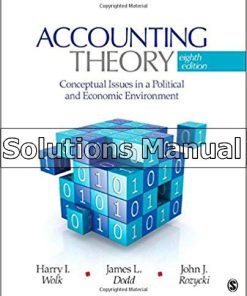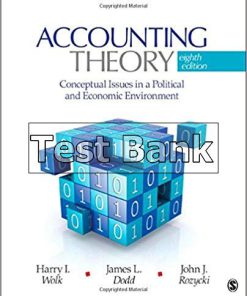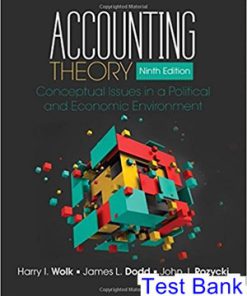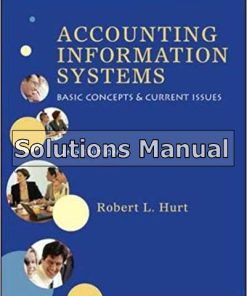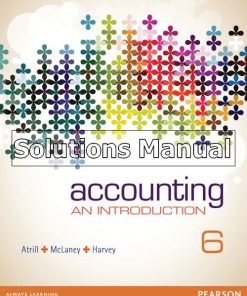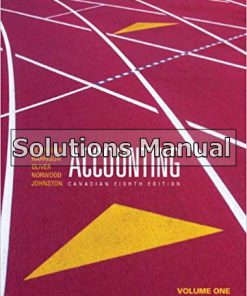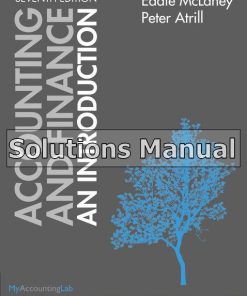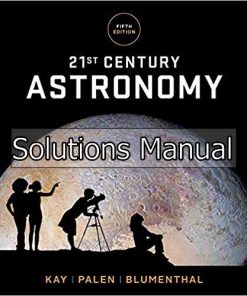Accounting Theory Conceptual Issues in a Political and Economic Environment 9th Edition Wolk Solutions Manual
$26.50$50.00 (-47%)
Accounting Theory Conceptual Issues in a Political and Economic Environment 9th Edition Wolk Solutions Manual.
You may also like
This is completed downloadable of Accounting Theory Conceptual Issues in a Political and Economic Environment 9th Edition Wolk Solutions Manual

Product Details:
- ISBN-10 : 9781483375021
- ISBN-13 : 978-1483375021
- Author:
This updated Ninth Edition of Accounting Theory: Conceptual Issues in a Political and Economic Environment continues to be one of the most relevant and comprehensive texts on accounting theory. Authors Harry I. Wolk, James L. Dodd, John J. Rozycki provide a critical overview of accounting as a whole as well as touch on the financial issues in economic and political contexts, providing readers with an applied understanding of how current United States accounting standards were derived and where we might be headed in the future. Readers will find learning tools such as questions, cases, problems and writing assignments to solidify their understanding of accounting theory and gain new insights into this evolving field.
Table of Content:
- 1. An Introduction to Accounting Theory
- Accounting Theory and Policy Making
- The Role of Measurement in Accounting
- Direct and Indirect Measurements
- Assessment and Prediction Measures
- The Measurement Process
- Types of Measurements
- Quality of Measurements
- Plan of This Book
- Summary
- Appendix 1-A: Valuation Systems
- The Simple Company
- Valuation Approaches to Accounting for the Simple Company
- Historical Cost
- General Price-Level Adjustment
- Current Value Systems
- Discounted Cash Flows
- Questions
- Cases, Problems, and Writing Assignments
- Critical Thinking and Analysis
- 2. Accounting Theory and Accounting Research
- Accounting Research and Scientific Method
- Research Approaches
- Normative and Descriptive Theories
- Global and Particularistic Theories
- Complementary Nature of Deductive and Inductive Methods
- Is Accounting an Art or a Science?
- Econometrics
- Climatology
- Human Anthropology
- Summary of Accounting as a Science
- Directions in Accounting Research
- The Decision-Model Approach
- Capital Markets Research
- Behavioral Research
- Agency Theory
- Information Economics
- Critical Accounting
- A Scientific Revolution in Accounting?
- Summary
- Questions
- Cases, Problems, and Writing Assignments
- Critical Thinking and Analysis
- 3. Development of the Institutional Structure of Financial Accounting
- Accounting in the United States Prior to 1930
- Formative Years, 1930 – 1946
- NYSE/AICPA Agreement
- Formation of the SEC
- Committee on Accounting Procedure, 1936 – 1946
- Postwar Period, 1946 – 1959
- ARB 32 and the SEC
- The Price-Level Problem
- Closing Years of the CAP
- A New Approach
- Modern Period, 1959 to the Present
- Early Years of the APB
- The FASB: An Overview
- Sarbanes-Oxley Act (SOX)
- Comparability Across International Borders
- The Liability Crisis in Public Accounting
- Current Role of the AICPA
- Current Role of the SEC
- Other Groups
- Summary
- Questions
- Cases, Problems, and Writing Assignments
- Critical Thinking and Analysis
- 4. The Economics of Financial Reporting Regulation
- The Case for Unregulated Markets for Accounting Information
- Agency Theory
- Competitive Capital Markets and Signaling Incentives
- Arguments in Favor of Private Contracting Opportunities
- The Case for Regulated Markets for Accounting Information
- Market Failures
- Social Goals
- The Codificational Justification of Standard Setting
- Comparing Regulated and Unregulated Markets
- Imperfections of Accounting Regulation
- The Regulatory Process
- The Political Nature of Regulation
- Regulatory Behavior
- Economic Consequences of Accounting Policy
- Summary
- Questions
- Cases, Problems, and Writing Assignments
- Critical Thinking and Analysis
- 5. Postulates, Principles, and Concepts
- Postulates and Principles
- The Special Committee on Research Program
- Accounting Research Study No. 1 (ARS 1)
- Accounting Research Study No. 3 (ARS 3)
- A Perspective on ARS 1 and ARS 3
- Basic Concepts Underlying Historical Costing
- Postulates
- Principles
- Input-Oriented Principles
- Output-Oriented Principles
- Equity Theories
- Proprietary Theory
- Entity Theory
- Residual Equity Theory
- Fund Theory
- Commander Theory
- Outlook on the Equity Theories
- Summary
- Appendix 5-A: The Basic Postulates of Accounting (ARS 1)
- Postulates Stemming from the Economic and Political Environment
- Postulates Stemming from the Field of Accounting Itself
- The Imperatives
- Appendix 5-B: A Tentative Set of Broad Accounting Principles for Business Enterprises (ARS 3)
- Questions
- Cases, Problems, and Writing Assignments
- Critical Thinking and Analysis
- 6. The Search for Objectives
- ASOBAT
- Development of the User Approach
- Orientation to Theory
- Objectives of Accounting
- Standards for Accounting Information
- Guidelines for Communicating Accounting Information
- Concluding Remarks on ASOBAT
- APB Statement 4
- Orientation to Definitions
- Other Aspects of APB Statement 4
- Concluding Remarks on APB Statement 4
- The Trueblood Committee Report
- Objectives of Financial Statements
- Concluding Remarks on the Trueblood Committee Report
- SATTA
- Theory Approaches in Accounting
- Concluding Remarks on SATTA
- User Objectives and User Diversity
- User Objectives
- User Diversity
- Summary
- Questions
- Cases, Problems, and Writing Assignments
- Critical Thinking and Analysis
- 7. The FASB ‘ s Conceptual Framework
- The FASB ‘ s Conceptual Framework
- Discussion Memorandum
- Statements of Financial Accounting Concepts
- Statement No. 1 (subsequently replaced by SFAC No. 8)
- Statement No. 2 (subsequently replaced by SFAC No. 8)
- Statement No. 3 (subsequently replaced by SFAC No. 6)
- Statement No. 4
- Statement No. 5
- Statement No. 6
- Statement No. 7
- Statement No. 8
- The Conceptual Framework as a Codificational Document
- The Jurisprudential View
- Empirical Research on the Conceptual Framework
- Assessing the Conceptual Framework
- Summary
- Questions
- Cases, Problems, and Writing Assignments
- Critical Thinking and Analysis
- 8. Usefulness of Accounting Information to Investors and Creditors
- Earnings, Dividends, and Stock Prices
- Earnings and Dividends
- Predicting Dividends From Current Earnings
- Connecting the Dots: From Earnings to Stock Prices
- Residual Income Models
- Economic Profit
- Residual Income and the Dividend Discount Model
- Residual Income and Performance Measurement: The Good and Bad
- Background on Risk and Return
- Efficient-Markets Hypothesis (EMH)
- Portfolio Diversification
- Capital Asset Pricing Model (CAPM)
- Introduction to Capital Markets Research in Accounting
- The Market Model
- Event Studies
- Overview of Capital Markets Research in Accounting
- The Value of Accounting Information: Evidence From Return Data
- Information Contents of Earnings Announcements
- Market Reaction to Alternative Accounting Policies
- Alternatives With No Known Cash Flow Consequences
- An Alternative With Cash Flow Consequences: The LIFO Choice
- Alternatives With Indirect Cash Consequences
- Anomalies
- The Incomplete Revelation Hypothesis
- Accounting Information and Risk Assessment
- Summary of Capital Market Research
- Evidence From Survey Data
- The Value of Accounting Information: Evidence From Direct Valuation
- Evidence From Pensions
- Evidence From Research and Development
- Evidence From Financial Services
- Accounting Data and Creditors
- Evidence From Bankruptcies
- Evidence From Credit Ratings
- Importance of Earnings Forecasting
- Empirical Research and Standard Setting
- Summary
- Questions
- Cases, Problems, and Writing Assignments
- Critical Thinking and Analysis
- 9. Uniformity and Disclosure: Some Policy-Making Directions
- What Underlies the Choice Among Accounting Methods?
- Uniformity
- The Nature and Complexity of Events
- Finite and Rigid Uniformity
- The Present Status of Uniformity
- The Usefulness of Accounting Allocations
- Disclosure
- The Disclosure Function of the SEC
- The Shift Toward Informative Disclosure
- Imperfections of the Disclosure Process
- Forms and Methods of Disclosure
- Improving Accounting Standards
- Summary
- Questions
- Cases, Problems, and Writing Assignments
- Critical Thinking and Analysis
- 10. International Accounting
- National Accounting Differences
- The Anglo-American Model
- The Continental Model
- Overview of National Profiles
- Problems Stemming From National Accounting Differences
- International Harmonization of Accounting Standards
- The EU
- The International Accounting Standards Board
- International Federation of Accountants (IFAC)
- United Nations (UN)
- Organisation for Economic Co-operation and Development (OECD)
- Summary
- Questions
- Cases, Problems, and Writing Assignments
- Critical Thinking and Analysis
- 11. The Balance Sheet
- The Relationship Between the Balance Sheet and the Income Statement
- Articulation
- The Nonarticulated Approach
- Assets
- Definition of Assets
- Executory Contracts
- Recognition and Measurement of Assets
- Summary of Asset Measurement
- Liabilities
- Definition of Accounting Liabilities
- Recognition and Measurement of Liabilities
- Summary of Liability Measurement
- Owners ‘ Equity
- Definition of Owners ‘ Equity
- Recognition and Measurement of Owners ‘ Equity
- Financial Instruments
- Derivatives
- Classification in the Balance Sheet
- Summary
- Appendix 11-A: A Simple Example of a Weather Derivative
- Questions
- Cases, Problems, and Writing Assignments
- Critical Thinking and Analysis
- 12. The Income Statement
- Income Definitions
- Revenues and Gains
- Revenue Recognition
- Expenses and Losses
- Future Events and Accounting Recognition
- Some Aspects of Future Events
- Summary of Future Events
- Current Operating Versus All-Inclusive Income
- Comprehensive Income
- Nonoperating Sections
- Extraordinary Items
- Accounting Changes
- Prior Period Adjustments
- Earnings per Share
- SFAS No. 128
- Specialized Subjects Concerning Income Measurement
- Development Stage Enterprises
- Troubled Debt Restructuring
- Early Extinguishment of Debt
- Stock Options
- Earnings Management
- Management Compensation
- Income Smoothing
- Income Statement Developments
- Cash Earnings
- Pro Forma Earnings and Offshoots
- Matrix Approaches
- Retrospective Reports
- Quality of Earnings
- Financial Statement Restatements
- Summary
- Questions
- Cases, Problems, and Writing Assignments
- Critical Thinking and Analysis
- 13. Statement of Cash Flows
- The Statement of Changes in Financial Position
- The Motivation for a Cash Flow Statement
- Objectives of Financial Reporting
- Objectives of the Statement of Cash Flows
- Requirements of the Cash Flow Statement
- Structure of the SCF
- The Nonarticulation Problem
- Classification Problems of SFAS No. 95
- International Accounting Standards (IAS)
- Premium and Discount on Bonds and Notes
- Increased Flexibility of Presentation
- Analytical Usefulness of the Cash Flow Statement
- Issues Relating to Rules for Classifying Cash Flows
- The SCF Is More Than Cash Flow From Operating Activities
- Cash Flow Needs of Different Users
- Cash and Funds Flow Research
- Improving the SCF
- Summary
- Questions
- Cases, Problems, and Writing Assignments
- Critical Thinking and Analysis
- 14. Income Taxes and Financial Accounting
- Income Tax Allocation
- The Rationale of Income Tax Allocation
- Tax Allocation and Accelerated Depreciation
- Interpreting Deferred Tax Credits
- Orientations to Income Tax Allocation
- Discounting Deferred Tax Liabilities
- Summary of Orientations to Income Tax Allocation
- Modified Accelerated Cost Recovery System
- The Asset – Liability Orientation of SFAS No. 109
- An Illustration
- Net Operating Losses and Income Tax Allocation
- Empirical Research on Income Tax Allocation
- International Accounting Standards (IAS)
- Improving Accounting Standards
- Summary
- Questions
- Cases, Problems, and Writing Assignments
- Critical Thinking and Analysis
- 15. Pensions and Other Postretirement Benefits
- Overview of Pension Plans
- Defined Contribution and Defined Benefit Plans
- Vesting
- Single- and Multiemployer Plans
- Actuarial Funding of Defined Benefit Plans
- Funding Complexities
- Actuarial Funding Methods
- Employee Retirement Income Security Act of 1974 (ERISA)
- Cash Balance Plans
- Legal Relationships in Defined Benefit Plans
- Accounting Issues Relating to Defined Benefit Pension Plans
- Development of Pension Accounting Standards
- ARB 36 (Codified as Chapter 13, Section A of ARB 43)
- ARB 47
- APB Opinion No. 8
- FASB Interpretation 3
- SFAS No. 35
- SFAS No. 36
- SFAS No. 87 and SFAS No. 88: Shifting to a Liability Orientation
- SFAS No. 132
- SFAS No. 158
- Empirical Research on Pensions
- Postretirement Benefits Other Than Pensions
- Explicit Health Care Trending
- The Mechanics of OPEB
- Major Features of SFAS No. 106
- SFAS No. 112
- Theoretical Aspects of OPEB Accounting
- Economic Consequences of OPEB Recognition
- Empirical Research on OPEBs
- International Accounting Standards (IAS)
- Improving Accounting Standards
- Summary
- Appendix 16-A: Illustration of Pension Expense Determination and Actuarial Funding Methods
- Accounting for Defined Benefit Plans
- Funding for Defined Benefit Plans
- Questions
- Cases, Problems, and Writing Assignments
- Critical Thinking and Analysis
- 16. Leases
- The Lease Contract
- The Executory Nature of Lease Contracts
- Leases Compared With Purchase Arrangements
- Lease Capitalization
- Capitalization for Lessees
- Legal Approach
- Material Equity
- Transfer of the Benefits and Risks of Ownership
- Capitalization for Lessors
- The Evolution of Lease Accounting Standards
- Lessee Accounting
- Lessor Accounting
- Sale and Leaseback
- Leveraged Leases
- Assessing SFAS No. 13
- Economic Consequences of Lease Capitalization
- The G4+1 Report on Leases
- FASB and IASB Joint Exposure Drafts on Accounting for Leases
- Exposure Draft 2010/9
- Exposure Draft 2013
- Post-Exposure Draft Deliberations
- Improving Accounting Standards
- Summary
- Questions
- Cases, Problems, and Writing Assignments
- Critical Thinking and Analysis
- 17. Intercorporate Equity Investments
- Relevant Circumstances
- Consolidation
- Pooling of Interests
- The Purchase Method
- The New Entity Approach
- Proportionate Consolidation
- Research on Pooling and Purchase Accounting
- The Equity Method
- The Fair Value Method
- Defining the Reporting Entity
- Translation of Foreign Operations
- SFAS No. 8
- SFAS No. 52
- IASB Standards
- Improving Accounting Standards
- Summary
- Appendix 17-A: Special Purpose Entities, Variable Interest Entities, and the Downfall of Enron
- Special Purpose Entities (SPEs)
- Variable Interest Entities (VIEs)
- A Final Accounting of Enron ‘ s Accounting
- Questions
- Cases, Problems, and Writing Assignments
- Critical Thinking and Analysis
- Notes
- References
- Name Index
- Subject Index
People Also Search:
accounting theory conceptual issues in a political and economic environment wolk
accounting theory conceptual issues in a political and economic environment 9th edition wolk
accounting theory conceptual issues in a political and economic environment
accounting theory conceptual issues in a political and economic environment 9th edition
accounting theory conceptual issues in a political and economic environment 9th edition solution manual download pdf
accounting theory conceptual issues in a political and economic environment 9th edition download scribd


